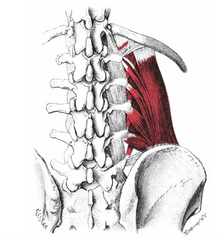Quadratus Lumborum Introduction:
Quadratus Lumborum Trigger Points:
Quadratus Lumborum Trigger Points Introduction:
Today's post dives into the trigger points of the QL muscle, as written by Janet Travell and David Simons in Myofascial Pain and Dysfunction - The Trigger Point Manual Third Edition [1]. This textbook contains 2169 pages and has over 57 contributors - it is the modern source of truth on the topic of trigger points. No one has time for that kind of reading, so let me summarize the key findings of Quadratus Lumborum trigger points.
Quadratus Lumborum is a deep, structural lower back muscle that can wreak havoc on the back when it contains trigger points. Anatomically, Quadratus Lumborum connects the top of the hip to the lowest (12th) rib and also connects to lumbar vertebrae in criss-cross patterns [1]. Quadratus Lumborum has two functions: to laterally bend the trunk when one lone QL muscle contracts, and to extend the spine when both QL muscles contract at the same time.

The Quadratus Lumborum Muscle [1] p. 1163. Quadratus Lumborum (red) attaches at the top of the Iliac Crest, the 12th rib, and vertebrae L1-L5.
Quadratus Lumborum Trigger Point Function:
Let's start with the textbook definition of Quadratus Lumborum's function: "research concludes that its primary functions are lateral flexion, extension, and stabilization of the trunk and lumbar spine in the frontal and horizontal planes" [1] p. 1167.
In other words, the QL's function is to side bend, straighten the spine, and stabilize the spine in the horizontal (aka transverse plane - the rotation plane) and frontal plane. Quadratus Lumborum is crucial in high-impact sports due to its stability and spinal movement functions. A strong QL is a great defense against spinal injury in intense activity with lots of trunk movement [1]. A few Quadratus Lumborum strengthening movements I love are side planks, suitcase carries, side bends, and hyperextensions.
What Are Quadratus Lumborum Trigger Points?
Quadratus Lumborum trigger points are taught, angry bands of muscle that hold a constant tension in the lower back. This can restrict movement, create imbalances, impinge nerves, and ultimately cause a great deal of pain.
"When patients report nonspecific low back pain (LBP), the quadratus lumborum muscle is typically found to be a contributing factor to the patient’s report of pain. Trigger points in the quadratus lumborum muscle are common in LBP, but this source is commonly overlooked." [1] p. 1172. In my opinion, trigger points are the biggest oversight in musculoskeletal medicine practice. Investigating trigger points is a very low-risk, high-return, cost-effective investment strategy for relieving conditions like back pain. Instead of trigger point therapy, unfortunately, most western medicine opts for expensive MRIs and PT/Chiropractic visits that can quickly add up.

Quadratus Lumborum Trigger Points Pain Pattern [1]
On page 1173 of Myofascial Pain and Dysfunction, the authors discuss a study that investigated 42 patients with nonspecific low back pain for trigger points [1]. The study found a mean active trigger point count of 3.5 per patient [1]. Quadratus Lumborum trigger points were the most prevalent in 55% of patients, followed by Gluteus Medius at 38% [1].
How To Release Quadratus Lumborum Trigger Points
The best way to release Quadratus Lumborum trigger points is using the QL Claw device. The QL Claw was designed to optimally access the QL muscle and massage the other 5 muscles that contribute to low back pain.

Quadratus Lumborum Trigger Point Release Using the QL Claw Device
Quadratus Lumborum trigger points can be worked out in a few brief sessions of intentional massage. While on your QL Claw, feel for tender spots in the Quadratus Lumborum and gently massage them out with your breath, weight, and light motion.
[1] Donnelly, Joseph M. Travell, Simons & Simons Myofascial Pain and Dysfunction: the Trigger Point Manual. 3rd ed., Wolters Kluwer Health, 2019.


